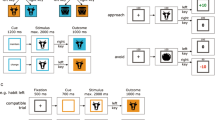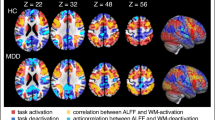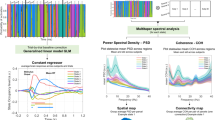Abstract
We experience surprise when reality conflicts with our expectations. When we encounter such expectation violations in psychological tasks and daily life, are we experiencing completely different forms of surprise? Or is surprise a fundamental psychological process with shared neural bases across contexts? To address this question, we identified a brain network model, the surprise edge-fluctuation-based predictive model (EFPM), whose regional interaction dynamics measured with functional magnetic resonance imaging (fMRI) predicted surprise in an adaptive learning task. The same model generalized to predict surprise as a separate group of individuals watched suspenseful basketball games and as a third group watched videos violating psychological expectations. The surprise EFPM also uniquely predicts surprise, capturing expectation violations better than models built from other brain networks, fMRI measures and behavioural metrics. These results suggest that shared neurocognitive processes underlie surprise across contexts and that distinct experiences can be translated into the common space of brain dynamics.
This is a preview of subscription content, access via your institution
Access options
Access Nature and 54 other Nature Portfolio journals
Get Nature+, our best-value online-access subscription
27,99 € / 30 days
cancel any time
Subscribe to this journal
Receive 12 digital issues and online access to articles
118,99 € per year
only 9,92 € per issue
Buy this article
- Purchase on SpringerLink
- Instant access to full article PDF
Prices may be subject to local taxes which are calculated during checkout




Similar content being viewed by others
Data availability
Helicopter learning task data are available at https://openneuro.org/datasets/ds003772/versions/1.0.1 (refs. 2,72). NCAA viewing data are available at https://openneuro.org/datasets/ds003338/versions/1.1.0 (refs. 20,73) and https://dataspace.princeton.edu/handle/88435/dsp019k41zh56d ref. 20. VoE data are available at https://openneuro.org/datasets/ds004934/versions/1.0.0 (refs. 39,40).
Code availability
Analysis code associated with this paper, including code for training and testing new edge-fluctuation-based predictive models, is available at https://github.com/ZiweiZhang0304/Surprise_EFPM.git ref. 79. We used the following versions of the softwares: MATLAB (R2020a), AFNI (v.19.0), R (v.4.0.5) and Python (3.12.2).
References
Baldi, P. & Itti, L. Of bits and wows: a Bayesian theory of surprise with applications to attention. Neural Netw. 23, 649–666 (2010).
McGuire, J. T., Nassar, M. R., Gold, J. I. & Kable, J. W. Functionally dissociable influences on learning rate in a dynamic environment. Neuron 84, 870–881 (2014).
Meyniel, F. & Dehaene, S. Brain networks for confidence weighting and hierarchical inference during probabilistic learning. Proc. Natl Acad. Sci. USA 114, E3859–E3868 (2017).
O’Reilly, J. X. et al. Dissociable effects of surprise and model update in parietal and anterior cingulate cortex. Proc. Natl Acad. Sci. USA 110, E3660–E3669 (2013).
Kao, C.-H. et al. Functional brain network reconfiguration during learning in a dynamic environment. Nat. Commun. 11, 1682 (2020).
Allen, E. A. et al. Tracking whole-brain connectivity dynamics in the resting state. Cereb. Cortex 24, 663–676 (2014).
Lurie, D. J. et al. Questions and controversies in the study of time-varying functional connectivity in resting fMRI. Netw. Neurosci. 4, 30–69 (2020).
Preti, M. G., Bolton, T. A. & Van De Ville, D. The dynamic functional connectome: state-of-the-art and perspectives. NeuroImage 160, 41–54 (2017).
Faskowitz, J., Esfahlani, F. Z., Jo, Y., Sporns, O. & Betzel, R. F. Edge-centric functional network representations of human cerebral cortex reveal overlapping system-level architecture. Nat. Neurosci. 23, 1644–1654 (2020).
Zamani Esfahlani, F. et al. High-amplitude cofluctuations in cortical activity drive functional connectivity. Proc. Natl Acad. Sci. USA 117, 28393–28401 (2020).
Betzel, R. F., Faskowitz, J. & Sporns, O. Living on the edge: network neuroscience beyond nodes. Trends Cogn. Sci. 27, 1068–1084 (2023).
Tanner, J. C. et al. Synchronous high-amplitude co-fluctuations of functional brain networks during movie-watching. Imaging Neurosci. 1, 1–21 (2023).
Kloosterman, N. A. et al. Pupil size tracks perceptual content and surprise. Eur. J. Neurosci. 41, 1068–1078 (2015).
Lavin, C., San Martín, R. & Rosales Jubal, E. Pupil dilation signals uncertainty and surprise in a learning gambling task. Front. Behav. Neurosci. 7, 218 (2014).
Liao, H.-I., Yoneya, M., Kashino, M. & Furukawa, S. Pupillary dilation response reflects surprising moments in music. J. Eye Mov. Res. https://doi.org/10.16910/jemr.11.2.13 (2018).
Preuschoff, K., Marius′t Hart, B. & Einhauser, W.Pupil dilation signals surprise: evidence for noradrenaline’s role in decision making. Front. Neurosci. 5, 115 (2011).
Chang, L. J. et al. Endogenous variation in ventromedial prefrontal cortex state dynamics during naturalistic viewing reflects affective experience. Sci. Adv. 7, eabf7129 (2021).
Itti, L. & Baldi, P. Bayesian surprise attracts human attention. Vis. Res. 49, 1295–1306 (2009).
Sutton, R. S. & Barto, A. G. Reinforcement Learning: An Introduction 2nd edn (MIT Press, 2018).
Antony, J. W. et al. Behavioral, physiological, and neural signatures of surprise during naturalistic sports viewing. Neuron 109, 377–390.e7 (2021).
Kumar, M. et al. Bayesian surprise predicts human event segmentation in story listening. Cogn. Sci. 47, e13343 (2023).
Nassar, M. R., Wilson, R. C., Heasly, B. & Gold, J. I. An approximately Bayesian delta-rule model explains the dynamics of belief updating in a changing environment. J. Neurosci. 30, 12366–12378 (2010).
Nassar, M. R. et al. Rational regulation of learning dynamics by pupil-linked arousal systems. Nat. Neurosci. 15, 1040–1046 (2012).
Rosenberg, M. D. et al. Functional connectivity predicts changes in attention observed across minutes, days, and months. Proc. Natl Acad. Sci. USA 117, 3797–3807 (2020).
Jones, H. M., Yoo, K., Chun, M. M. & Rosenberg, M. D. Edge-based general linear models capture moment-to-moment fluctuations in attention. J. Neurosci. 44, e1543232024 (2024).
Shine, J. M. et al. The dynamics of functional brain networks: integrated network states during cognitive task performance. Neuron 92, 544–554 (2016).
Taghia, J. et al. Uncovering hidden brain state dynamics that regulate performance and decision-making during cognition. Nat. Commun. 9, 2505 (2018).
Bassett, D. S. et al. Dynamic reconfiguration of human brain networks during learning. Proc. Natl Acad. Sci. USA 108, 7641–7646 (2011).
Song, H., Finn, E. S. & Rosenberg, M. D. Neural signatures of attentional engagement during narratives and its consequences for event memory. Proc. Natl Acad. Sci. USA 118, e2021905118 (2021).
Finn, E. S. et al. Functional connectome fingerprinting: identifying individuals based on patterns of brain connectivity. Nat. Neurosci. 18, 1664–1671 (2015).
Brandman, T., Malach, R. & Simony, E. The surprising role of the default mode network in naturalistic perception. Commun. Biol. 4, 79 (2021).
Hindriks, R. et al. Can sliding-window correlations reveal dynamic functional connectivity in resting-state fMRI? NeuroImage 127, 242–256 (2016).
Hutchison, R. M. et al. Dynamic functional connectivity: promise, issues, and interpretations. NeuroImage 80, 360–378 (2013).
van der Meer, J. N., Breakspear, M., Chang, L. J., Sonkusare, S. & Cocchi, L. Movie viewing elicits rich and reliable brain state dynamics. Nat. Commun. 11, 5004 (2020).
Simony, E. et al. Dynamic reconfiguration of the default mode network during narrative comprehension. Nat. Commun. 7, 12141 (2016).
Shen, X., Tokoglu, F., Papademetris, X. & Constable, R. T. Groupwise whole-brain parcellation from resting-state fMRI data for network node identification. NeuroImage 82, 403–415 (2013).
Rosenberg, M. D. et al. A neuromarker of sustained attention from whole-brain functional connectivity. Nat. Neurosci. 19, 165–171 (2016).
Yu, A. J. & Dayan, P. Uncertainty, neuromodulation, and attention. Neuron 46, 681–692 (2005).
Liu, S., Lydic, K., Mei, L. & Saxe, R. Violations of physical and psychological expectations in the human adult brain. Imaging Neurosci. 2, 1–25 (2024).
Liu, S., Lydic, K., Mei, L. & Saxe, R. fMRI dataset: violations of psychological and physical expectations in human adult brains. OpenNeuro https://doi.org/10.18112/openneuro.ds004934.v1.0.0 (2024).
Saxe, R., Tzelnic, T. & Carey, S. Five-month-old infants know humans are solid, like inanimate objects. Cognition 101, B1–B8 (2006).
Huang, L., Mo, L. & Li, Y. Measuring the interrelations among multiple paradigms of visual attention: an individual differences approach. J. Exp. Psychol. Hum. Percept. Perform. 38, 414–428 (2012).
Yoo, K. et al. A brain-based general measure of attention. Nat. Hum. Behav. 6, 782–795 (2022).
Gärtner, A. & Strobel, A. Individual differences in inhibitory control: a latent variable analysis. J. Cognition 4, 17 (2021).
Wessel, J. R. et al. Surprise disrupts cognition via a fronto-basal ganglia suppressive mechanism. Nat. Commun. 7, 11195 (2016).
Mazancieux, A. et al. Brainstem fMRI signaling of surprise across different types of deviant stimuli. Cell Rep. 42, 113405 (2023).
Sebastian, A. et al. Surprise: unexpected action execution and unexpected inhibition recruit the same fronto-basal-ganglia network. J. Neurosci. 41, 2447–2456 (2021).
Russo, A. G. et al. Semantics-weighted lexical surprisal modeling of naturalistic functional MRI time-series during spoken narrative listening. NeuroImage 222, 117281 (2020).
Cheung, V. K. M. et al. Uncertainty and surprise jointly predict musical pleasure and amygdala, hippocampus, and auditory cortex activity. Curr. Biol. 29, 4084–4092.e4 (2019).
D’Esposito, M., Zarahn, E. & Aguirre, G. K. Event-related functional MRI: implications for cognitive psychology. Psychol. Bull. 125, 155–164 (1999).
Mather, M., Cacioppo, J. T. & Kanwisher, N. How fMRI can inform cognitive theories. Perspect. Psychol. Sci. 8, 108–113 (2013).
Thiebaut de Schotten, M. & Forkel, S. J. The emergent properties of the connected brain. Science 378, 505–510 (2022).
Varela, F. J., Thompson, E. & Rosch, E. in The Embodied Mind: Cognitive Science and Human Experience (eds Varela, F. J. et al.) Ch. 5 (MIT Press, 2017).
Jordan, R. & Keller, G. B. The locus coeruleus broadcasts prediction errors across the cortex to promote sensorimotor plasticity. eLife 12, RP85111 (2023).
Valdés-Baizabal, C., Carbajal, G. V., Pérez-González, D. & Malmierca, M. S. Dopamine modulates subcortical responses to surprising sounds. PLoS Biol. 18, e3000744 (2020).
Rutledge, R. B., Dean, M., Caplin, A. & Glimcher, P. W. Testing the reward prediction error hypothesis with an axiomatic model. J. Neurosci. 30, 13525–13536 (2010).
Schultz, W., Dayan, P. & Montague, P. R. A neural substrate of prediction and reward. Science 275, 1593–1599 (1997).
Barto, A., Mirolli, M. & Baldassarre, G.Novelty or Surprise? Front. Psychol. 4, 907 (2013).
Niv, Y., Edlund, J. A., Dayan, P. & O’Doherty, J. P. Neural prediction errors reveal a risk-sensitive reinforcement-learning process in the human brain. J. Neurosci. 32, 551–562 (2012).
Dohmatob, E., Dumas, G. & Bzdok, D. Dark control: the default mode network as a reinforcement learning agent. Hum. Brain Mapp. 41, 3318–3341 (2020).
Yeshurun, Y., Nguyen, M. & Hasson, U. The default mode network: where the idiosyncratic self meets the shared social world. Nat. Rev. Neurosci. 22, 181–192 (2021).
Wang, Y. et al. Neural substrates of updating the prediction through prediction error during decision making. NeuroImage 157, 1–12 (2017).
Wu, T., Schulz, K. P. & Fan, J. Activation of the cognitive control network associated with information uncertainty. NeuroImage 230, 117703 (2021).
Owen, L. L. W., Chang, T. H. & Manning, J. R. High-level cognition during story listening is reflected in high-order dynamic correlations in neural activity patterns. Nat. Commun. 12, 5728 (2021).
Cao, H. et al. Toward leveraging human connectomic data in large consortia: generalizability of fMRI-based brain graphs across sites, sessions, and paradigms. Cereb. Cortex 29, 1263–1279 (2019).
Rosenberg, M. D. & Finn, E. S. How to establish robust brain–behavior relationships without thousands of individuals. Nat. Neurosci. 25, 835–837 (2022).
Woo, C.-W., Chang, L. J., Lindquist, M. A. & Wager, T. D. Building better biomarkers: brain models in translational neuroimaging. Nat. Neurosci. 20, 365–377 (2017).
Fischer, J., Mikhael, J. G., Tenenbaum, J. B. & Kanwisher, N. Functional neuroanatomy of intuitive physical inference. Proc. Natl Acad. Sci. USA 113, E5072–E5081 (2016).
Flavell, S. W., Gogolla, N., Lovett-Barron, M. & Zelikowsky, M. The emergence and influence of internal states. Neuron 110, 2545–2570 (2022).
Greene, A. S., Horien, C., Barson, D., Scheinost, D. & Constable, R. T. Why is everyone talking about brain state? Trends Neurosci. 46, 508–524 (2023).
McCormick, D. A., Nestvogel, D. B. & He, B. J. Neuromodulation of brain state and behavior. Annu. Rev. Neurosci. 43, 391–415 (2020).
McGuire, J. T., Nassar, M. R., Gold, J. I. & Kable, J. W. Functionally dissociable influences on learning rate in a dynamic environment. OpenNeuro https://doi.org/10.18112/openneuro.ds003772.v1.0.1 (2021).
Antony, J. et al. Behavioral, physiological, and neural signatures of surprise during naturalistic sports viewing. OpenNeuro https://doi.org/10.18112/openneuro.ds003338.v1.1.0 (2021).
Antony, J. W., Van Dam, J., Massey, J. R., Barnett, A. J. & Bennion, K. A. Long-term, multi-event surprise correlates with enhanced autobiographical memory. Nat. Hum. Behav. https://doi.org/10.1038/s41562-023-01631-8 (2023).
Rasero, J. et al. Similarity in evoked responses does not imply similarity in macroscopic network states. Netw. Neurosci. 8, 335–354 (2024).
Nastase, S. A., Gazzola, V., Hasson, U. & Keysers, C. Measuring shared responses across subjects using intersubject correlation. Soc. Cogn. Affect. Neurosci. 14, 667–685 (2019).
Patel, A. X. et al. A wavelet method for modeling and despiking motion artifacts from resting-state fMRI time series. NeuroImage 95, 287–304(2014).
Colclough, G. L., Brookes, M. J., Smith, S.M., & Woolrich, M. W. A symmetric multivariate leakage correction for MEG connectomes. Neuroimage 117, 439–448 (2015).
Zhang, Z. (2023). Surprise_EFPM. GitHub https://github.com/ZiweiZhang0304/Surprise_EFPM.git (2023).
Acknowledgements
We thank J. T. McGuire, J. W. Kable and C.-H. Kao for sharing and addressing questions about the MRI and behavioural data associated with refs. 2,5; J. W. Antony for sharing and addressing questions about the MRI data, behavioural data and analysis scripts associated with ref. 20; S. Liu for sharing and addressing questions about the MRI data associated with ref. 39; J. Faskowitz and colleagues for making the code associated with ref. 9 publicly available, which we adapted and used in this work; Veritone and the NCAA for permission to use basketball game screenshots; Y. Chang Leong, K. Yoo, H. Song and W. X. Q. Ngiam for helpful feedback and suggestions on this work. The research was supported by National Science Foundation BCS-2043740 and Alfred P. Sloan Research Fellowship in Neuroscience FG-2022-19032 to M.D.R. and resources provided by the University of Chicago Research Computing Center. The funders had no role in study design, data collection and analysis, decision to publish or preparation of the manuscript.
Author information
Authors and Affiliations
Contributions
Z.Z. and M.D.R. conceptualized the study. Z.Z. curated and analysed the data. M.D.R. acquired funding and supervised the research. Z.Z. and M.D.R. wrote the paper.
Corresponding authors
Ethics declarations
Competing interests
The authors declare no competing interests.
Peer review
Peer review information
Nature Human Behaviour thanks Choong-Wan Woo, Marta Ceko and the other, anonymous, reviewer(s) for their contribution to the peer review of this work. Peer reviewer reports are available.
Additional information
Publisher’s note Springer Nature remains neutral with regard to jurisdictional claims in published maps and institutional affiliations.
Supplementary information
Rights and permissions
Springer Nature or its licensor (e.g. a society or other partner) holds exclusive rights to this article under a publishing agreement with the author(s) or other rightsholder(s); author self-archiving of the accepted manuscript version of this article is solely governed by the terms of such publishing agreement and applicable law.
About this article
Cite this article
Zhang, Z., Rosenberg, M.D. Brain network dynamics predict moments of surprise across contexts. Nat Hum Behav 9, 554–568 (2025). https://doi.org/10.1038/s41562-024-02017-0
Received:
Accepted:
Published:
Issue Date:
DOI: https://doi.org/10.1038/s41562-024-02017-0
This article is cited by
-
Predicting surprise across contexts
Nature Human Behaviour (2024)



